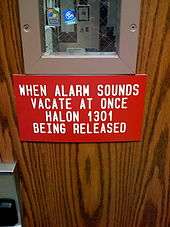Gaseous fire suppression
Gaseous fire suppression, also called clean agent fire suppression, is a term to describe the use of inert gases and chemical agents to extinguish a fire. These agents are governed by the National Fire Protection Association (NFPA) Standard for Clean Agent Fire Extinguishing Systems – NFPA 2001 in the US, with different standards and regulations elsewhere. The system typically consists of the agent, agent storage containers, agent release valves, fire detectors, fire detection system (wiring control panel, actuation signaling), agent delivery piping, and agent dispersion nozzles. Less typically, the agent may be delivered by means of solid propellant gas generators that produce either inert or chemically active gas.

Theory
There are four means used by the agents to extinguish a fire. They act on the "fire tetrahedron":
- Reduction or isolation of fuel. No agents currently use this as the primary means of fire suppression.
- Reduction of heat. Representative agents: Clean agent FS 49 C2 (NAF S 227, MH227, FM-200), Novec 1230, pentafluoroethane (NAF S125, ECARO-25).
- Reduction or isolation of oxygen: Representative agents: Argonite / IG-55 (ProInert), CO
2 carbon dioxide, Inert Gas 541 IG-541 Inergen, and IG-100 (NN100). - Inhibiting the chain reaction of the above components. Representative agents: FE-13, 1,1,1,2,3,3,3-Heptafluoropropane, FE-25, haloalkanes, bromotrifluoromethane, trifluoroiodomethane, NAF P-IV, NAF S-III, NAF S 125, NAF S 227, and Triodide (Trifluoroiodomethane).
Application
Broadly speaking, there are two methods for applying an extinguishing agent: total flooding and local application:
- Systems working on a total flooding principle apply an extinguishing agent to a three dimensional enclosed space in order to achieve a concentration of the agent (volume percent of the agent in air) adequate to extinguish the fire. These types of systems may be operated automatically by detection and related controls or manually by the operation of a system actuator.
- Systems working on a local application principle apply an extinguishing agent directly onto a fire (usually a two dimensional area), or into the three dimensional region immediately surrounding the substance or object on fire. The main difference in local application from total flooding design is the absence of physical barriers enclosing the fire space.
In the context of automatic extinguishing systems, local application generally refers to the use of systems that have been emplaced some time prior to their usage rather than the use of manually operated wheeled or portable fire extinguishers, although the nature of the agent delivery is similar and many automatic systems may also be activated manually. The lines are blurred somewhat with portable automatic extinguishing systems, although these are not common.
Safety precautions
Suffocation

An extinguishing system which is primarily based on inert gases in enclosed spaces presents a risk of suffocation. Some incidents have occurred where individuals in these spaces have been killed by carbon dioxide agent release (only in the case of CO2 carbon dioxide systems). When installed according to fire codes the systems have an excellent safety record. To prevent such occurrences, additional life safety systems are typically installed with a warning alarm that precedes the agent release. The warning, usually an audible and visible alert, advises the immediate evacuation of the enclosed space. After a preset time, the agent starts to discharge. This can be paused by activating an abort switch, which pauses the countdown as long as it is activated, allowing everyone to evacuate the area. Accidents have also occurred during maintenance of these systems, so proper safety precautions must be taken beforehand.[1]
Barotrauma
Barotrauma is physical damage to body tissues caused by a difference in pressure between a gas space inside, or in contact with the body, and the surrounding environment.[2] The positive pressure caused by these gases may be sufficient to break windows and walls. Humans and structures must be adequately protected and ventilation/blow-off must be considered when designing the system.
See also
- Fire protection
- Hypoxic air technology for fire prevention
- Inert Gas 541
References
- "Gas extinguishing system may blow out walls and windows". blog.anta.net. 2009-04-14. ISSN 1797-1993. Archived from the original on 2011-07-26. Retrieved 2009-04-14.
- US Navy Diving Manual, 6th revision. United States: US Naval Sea Systems Command. 2006. Archived from the original on 2002-08-09. Retrieved 2008-05-26.
.jpg)